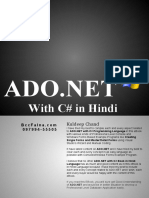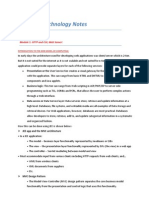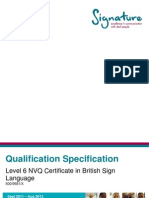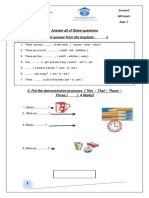Hindi To Chhattisgarhi Translator
Hindi To Chhattisgarhi Translator
Uploaded by
Shubham KumarCopyright:
Available Formats
Hindi To Chhattisgarhi Translator
Hindi To Chhattisgarhi Translator
Uploaded by
Shubham KumarOriginal Title
Copyright
Available Formats
Share this document
Did you find this document useful?
Is this content inappropriate?
Copyright:
Available Formats
Hindi To Chhattisgarhi Translator
Hindi To Chhattisgarhi Translator
Uploaded by
Shubham KumarCopyright:
Available Formats
www.ijcrt.
org © 2018 IJCRT | Volume 6, Issue 1 March 2018 | ISSN: 2320-2882
Hindi to Chhattisgarhi Translator
1
Shubham Kumar sahu, 2Anupriya dutta , 3Manish Kumar sinha, 4Sachin ther
Department of Information Technology, Bhilai Institute of technology ,Durg ,Chhattisgarh , India
Abstract: - A natural language translator translates one language into another with the help of certain logic, rules and algorithms.
Our work will translate Hindi language to Chhattisgarhi and vice-versa. We will also need a POS tagger for this which we have
already created earlier and for making this work correctly we have taken help from linguistic expert from a university in
Chhattisgarh who teaches Chhattisgarhi there. We have used an online tool Lingojam to make possible our translator is
completely online and tool based.
Keywords:-Translator, Chhattisgarhi, Hindi, lingojam
I. INTRODUCTION
To make a translator first we need to understand the basic structure of sentence of both the languages, here the best part is the
script of the both the languages is same that is Devanagari , and the structure of the sentence is also 70-80% is the same so we
don’t need a language parser for making a translator here, and only few parts are there where structure of the sentence is not same
, there the lingojam tools provide re-ordering and arranging of sentences but for that the words should be tagged and for that we
can use a POS(parts of speech) tagger for Chhattisgarhi and Hindi language both. Our work is completely new and nothing has
been done for Chhattisgarhi language
1.1 ABOUT LINGOJAM
It’s an Open Source Toolkit for Statistical Machine Translation.it is developed by Australian company. Apart from providing an
open-source toolkit for SMT, a further motivation for Lingojam is to extend phrase-based translation with factors and confusion
network decoding
II. DETAILS OF TOOL AND USING METHOD
This tool can be easily found on the search engines and Google , the URL of the tool is https://lingojam.com where anyone can
go and create a translator
2.1 USING PHRASES OPTION
Phrases are exchanged first. Place phrases from language 1 (usually just plain English) into the first column, and then place
what you want it to change into in the second column. Usually for Hindi to Chhattisgarhi translation basically where we need
to replace one word with more than one words or vice –versa we use this option examples in the image below
2.2 USING WORDS OPTION
These two lists will be the foundation of your translator. If your users type a word that's in the first column, it will be translated
to the word in the second column. Remember: Words at the top of the list will be the first ones translated (after phrases). Press
Enter to make a new line for each new word. Here's a list of common English words in case you need it. For Chhattisgarhi as I
mentioned earlier for 70-80% of the language the structure is the same so what we need to do is just replace the words of Hindi
for that exact same word existing in Chhattisgarhi for this words option of this tool is helpful examples in the image below
IJCRT1801638 International Journal of Creative Research Thoughts (IJCRT) www.ijcrt.org 755
www.ijcrt.org © 2018 IJCRT | Volume 6, Issue 1 March 2018 | ISSN: 2320-2882
2.3 USING ORDERING OPTION
(This is a new feature, please report bugs and feel free to make suggestions!) Use this section to change the ordering of words
based on their tagged word type. Tag your words by appending {{noun}}, {{verb}}, {{adjective}}, or any other tag you want
(e.g. {{fruit}}, {{animal}}) to the end of words in your word list. Then you can switch the ordering from (for example)
adjective->noun to noun->adjective by putting "adjective noun" in the left box and "noun adjective" in the right box (without
the quotation marks). IMPORTANT: You should only add {{tags}} your language 2 words (the box on the right hand side in
the 'words' tab) if you only want swapping to occur in the forward translations, otherwise tag both columns. For Hindi to
Chhattisgarhi, Hindi tagger is available online and for Chhattisgarhi we have made and automatic POS tagger for
Chhattisgarhi, which will help this to tag each word and this ordering and tagging, is the part on which we are still working to
make it more accurate.
There are more other options on this tools but we are not using that we will only discuss on options which we are currently
using. With all the options above discussed we can successfully make a Hindi to Chhattisgarhi Translator and the only extra
thing needed is POS tagger and database to feed in to the tool which we are making, currently the translator is working but the
size of database is small and we are increasing it day by day
III. WORKING OF TRANSLATOR
After knowing about the tools and its various options and how to use it and which option are we going to use which will fulfill our
needs we just need to feed the data in the options discussed above and what type of data is to be feed is also shown in the images
above. So basically what our translator does is 3 things and that also sequentially one by one. We can now them by menus that is
(1) phrases (2) words (3) ordering
3.1 TRANSLATION METHOD
The phrases options works at the start it finds the words that are there in its databases and replaces it with words which are in
the next column, then comes the time for words option this option finds the sentences for the words which are in its databases
of first column and replaces it with the words which are in the second column , then the last option works the ordering option
according to tags given to each language for both the languages the rule for reordering is to be set and then after replacing the
words to make it grammatically correct the words need to be re-ordered , example of such a rule to be reordered is
NP NP V GF ⇒ NP V GF NP.
This kind of rules is to be set to make it correct at the end and for various kinds of sentences various such rules is needed to be
feed on the tool on which we are currently working.
This three options when works one by one in correct order that makes our translator works correctly and the order of their
working is (1) phrases (2) words (3) ordering
IV. RESULTS AND DISCUSSION
URL of our Hindi to Chhattisgarhi translator is https://lingojam.com/hinditochhattishgarhi , currently our translator is 70-75%
accurate we are making our database large to make it more accurate, see the results and translated examples in image
IJCRT1801638 International Journal of Creative Research Thoughts (IJCRT) www.ijcrt.org 756
www.ijcrt.org © 2018 IJCRT | Volume 6, Issue 1 March 2018 | ISSN: 2320-2882
Currently we tested our translator with this following lines and it worked correctly
V. CONCLUSION
Our translator successfully translates the sentences which are feeded in the tool in its database and other sentences which are not
feeded its unable to translate therefore we need a bigger corpus and a bigger database of replacing exact words, otherwise the
tools and the set of rules and algorithm that we made are very much accurate to translate we made only one side rule and the other
side translation is done by the tool its self.
IJCRT1801638 International Journal of Creative Research Thoughts (IJCRT) www.ijcrt.org 757
www.ijcrt.org © 2018 IJCRT | Volume 6, Issue 1 March 2018 | ISSN: 2320-2882
VI. FUTURE SCOPE
Speech based translation system could be made in future using our translator and this translator is basically rule based translator
to make it more accurate a translator can also be made using a language parser and using various many more natural language
processing tools
VII. REFERENCES
[1] [Avramidis2012] Avramidis, E. (2012). Quality estimation for machine translation output using linguistic analysis and
decoding features. In Proceedings of the Seventh Workshop on Statistical Machine Translation, pages 84–90. Association for
Computational Linguistics.
[2] [Bharati et al.2006] Bharati, A., Sangal, R., Sharma, D. M., and Bai, L. (2006). Anncorra annotating corpora guidelines for
pos and chunk annotation for indian languages. LTRC-TR31.
[3] [Bojar et al.2013] Bojar, O., Buck, C., Callison-Burch, C., Federmann, C., Haddow, B., Koehn, P.,Monz, C., Post, M.,
Soricut, R., and Specia, L. (2013). Findings of the 2013 workshop on statistical machine translation.In 8th Workshop on
Statistical Machine Translation.
[4] [Bojar et al.2014] Bojar, O., Buck, C., Federmann, C., Haddow, B., Koehn, P., Leveling, J., Monz, C., Pecina, P., Post, M.,
Saint-Amand, H., et al. (2014). Findings of the 2014 workshop on statistical machine translation. In Proceedings of the Ninth
Workshop on Statistical Machine Translation, pages 12–58. Association for Computational Linguistics Baltimore, MD, USA.
[5] [Callison-Burch et al.2011] Callison-Burch, C., Koehn, P., Monz, C., and Zaidan, O. (2011). Findings of the 2011 workshop
on statistical machine translation. In Proceedings of the Sixth Workshop on Statistical Machine Translation, pages 22–64,
Edinburgh, Scotland, July. Association for Computational Linguistics.
[6] Callison-Burch et al.2012] Callison-Burch, C., Koehn, P., Monz, C., Post, M., Soricut, R., and Specia, L. (2012). Findings of
the 2012 workshop on statistical machine translation. In Proceedings of the Seventh Workshop on Statistical Machine
Translation, pages 10–51, Montréal, Canada, June. Association for Computational Linguistics.
[7] [Chiang2007] Chiang, D. (2007). Hierarchical phrase-based translation.computational linguistics,33(2):201–228.
[8]Gurpreet Singh Josan, Punjabi to Hindi machine translation system , COLING '08 22nd International Conference on on
Computational Linguistics: Demonstration Papers
Pages 157-160
IJCRT1801638 International Journal of Creative Research Thoughts (IJCRT) www.ijcrt.org 758
You might also like
- Inspire English Year 8 Student Book Answer KeyDocument84 pagesInspire English Year 8 Student Book Answer KeyHanaa Elmostaeen67% (9)
- Modern English in Action Christ Henry I Henry 1915 Annas ArchiveDocument584 pagesModern English in Action Christ Henry I Henry 1915 Annas Archivejinna kvp100% (1)
- PHP Mini Project - Front, Bonafide & IndexDocument3 pagesPHP Mini Project - Front, Bonafide & IndexArunabha BasakNo ratings yet
- The Javascript Language: Ilya KantorDocument11 pagesThe Javascript Language: Ilya KantorDevi Vara Prasad OptimisticNo ratings yet
- Assignment T&PDocument10 pagesAssignment T&PAlejandra TovarNo ratings yet
- Pitman Shorthand Guide English Tamil DictionaryDocument431 pagesPitman Shorthand Guide English Tamil DictionaryChellappaNo ratings yet
- CppinhindiDocument134 pagesCppinhindiapi-260150003No ratings yet
- withCSharpinHindi PDFDocument51 pageswithCSharpinHindi PDFSATNAM Singh0% (1)
- Hollywood Movies Only Hindi AudiosDocument1 pageHollywood Movies Only Hindi Audiosneeraj0309No ratings yet
- Web Technology NotesDocument13 pagesWeb Technology NotesSuyog DeoreNo ratings yet
- AdvanceJS in HindiDocument137 pagesAdvanceJS in HindiAmit PrajapatiNo ratings yet
- Javascript Interview Questions and AnswersDocument20 pagesJavascript Interview Questions and AnswersAdarsh KumarNo ratings yet
- DBMS & SQLDocument34 pagesDBMS & SQLSharad DhumalNo ratings yet
- OOPS TrainingDocument37 pagesOOPS Trainingkris2tmgNo ratings yet
- Computer Masti Book 1 PDFDocument88 pagesComputer Masti Book 1 PDFmeenahilNo ratings yet
- Chottu Sharma NotesDocument173 pagesChottu Sharma NotesGaurav Singh100% (1)
- Course: C++ Programming Sub Code: 23A: Oops ConceptDocument30 pagesCourse: C++ Programming Sub Code: 23A: Oops ConceptThaddeus MooreNo ratings yet
- C Programming LanguageDocument191 pagesC Programming LanguageKarthikeyan KNo ratings yet
- Image Processing - Using Machine Learning: Software Requirement SpecificationDocument19 pagesImage Processing - Using Machine Learning: Software Requirement Specification9609762955No ratings yet
- Unit-3 Software: Need of Computer SoftwareDocument10 pagesUnit-3 Software: Need of Computer SoftwareSandhya KandikatlaNo ratings yet
- CSS Tutorial in HindiDocument12 pagesCSS Tutorial in HindiRamnath Ray YadavNo ratings yet
- DBMS1 7Document531 pagesDBMS1 7savoir001No ratings yet
- Qbasic NotesDocument7 pagesQbasic Notesjecom79703No ratings yet
- Suresh Interview QuestionsDocument10 pagesSuresh Interview Questionsprasad.nallani6990100% (1)
- Css Course OutlineDocument10 pagesCss Course OutlineUmar IsrarNo ratings yet
- C Programming Interview QuestionsDocument8 pagesC Programming Interview QuestionsIoana TureanNo ratings yet
- PHP NotesDocument149 pagesPHP NotesNavaneet Knights100% (1)
- 1.3.1 Hardware SpecificationDocument6 pages1.3.1 Hardware Specificationsuriya extazeeNo ratings yet
- What Are The Different Type of SQL's StatementsDocument10 pagesWhat Are The Different Type of SQL's StatementsManishkantMahtoNo ratings yet
- Visual Basic 6 - Hindi Notes PDFDocument113 pagesVisual Basic 6 - Hindi Notes PDFAKASH JAISWALNo ratings yet
- Begin To Code With JavaScript by Rob Miles DraftDocument415 pagesBegin To Code With JavaScript by Rob Miles Draftthe4powerNo ratings yet
- PDF Ebooks PHP EbookDocument34 pagesPDF Ebooks PHP EbookBasant PaliwalNo ratings yet
- Infosys Technical Interview QuestionsDocument29 pagesInfosys Technical Interview QuestionsHarpreet Singh BaggaNo ratings yet
- SQL Interview QuestionsDocument12 pagesSQL Interview Questionsapi-20015660100% (1)
- Home Automation Using Arduino and PIRDocument50 pagesHome Automation Using Arduino and PIRanil kumarNo ratings yet
- Advance Js in HindiDocument112 pagesAdvance Js in HindiManav Gupta33% (3)
- Bca-Vi Sem-Pc HW and Network-SylDocument6 pagesBca-Vi Sem-Pc HW and Network-Syllo leeeNo ratings yet
- Difference Between DBMS and RDBMSDocument16 pagesDifference Between DBMS and RDBMSRachita KhandelwalNo ratings yet
- Oracle Book in Hindi PDF DownloadDocument51 pagesOracle Book in Hindi PDF DownloadSharad DhumalNo ratings yet
- Database and RDBMSDocument14 pagesDatabase and RDBMSAkash DeepNo ratings yet
- Important Interview QuitionsDocument34 pagesImportant Interview QuitionsSudheer Reddy PothuraiNo ratings yet
- CinHindi PDFDocument106 pagesCinHindi PDFDeepal A ShahNo ratings yet
- PHP (4th) May2019 PDFDocument2 pagesPHP (4th) May2019 PDFanil kumarNo ratings yet
- HTML Css W3schoolsDocument54 pagesHTML Css W3schoolsHani JahanNo ratings yet
- QuestionsDocument410 pagesQuestionsKamlesh KumarNo ratings yet
- Perl 4Document112 pagesPerl 4AgnathavasiNo ratings yet
- Chapter 04 PHP and MysqlDocument49 pagesChapter 04 PHP and MysqlMarichris VenturaNo ratings yet
- ASP by AkatsukiDocument44 pagesASP by Akatsukiranasjantilal1967No ratings yet
- Finding Awesome Developers in Programming Interviews: Part I: Testing Assumptions From The ResumeDocument4 pagesFinding Awesome Developers in Programming Interviews: Part I: Testing Assumptions From The ResumeTim HeronNo ratings yet
- Major Training ReportDocument27 pagesMajor Training ReportFarooq AhmedNo ratings yet
- Lecture 4 - Decisions and Conditions - EDITEDDocument24 pagesLecture 4 - Decisions and Conditions - EDITEDPearl Kimberly Quidor Lavarez100% (1)
- Java ExercisesDocument3 pagesJava ExercisesSukhanya AyappanNo ratings yet
- Pgdca 2 Sem PDFDocument11 pagesPgdca 2 Sem PDFAjeet BansalNo ratings yet
- MultimediaDocument82 pagesMultimediaAnkit malviyaNo ratings yet
- Fundamentals of HTML: Hypertext Refers To The Way in Which Web Pages (HTML Documents) Are Linked TogetherDocument31 pagesFundamentals of HTML: Hypertext Refers To The Way in Which Web Pages (HTML Documents) Are Linked TogetherArshdeep SinghNo ratings yet
- Core Java NotesDocument13 pagesCore Java NotesSHANTANU BHATTACHARYANo ratings yet
- LinuxDocument16 pagesLinuxdeepikasorout007No ratings yet
- ReactJS, Logic Building QuestionsDocument5 pagesReactJS, Logic Building QuestionsHAnsianNo ratings yet
- All About Computer Practice Hindi PDFDocument42 pagesAll About Computer Practice Hindi PDFRaj ChaudharyNo ratings yet
- Web Technology NotesDocument72 pagesWeb Technology NotesjamieabeyNo ratings yet
- ColdFusion Interview Questions, Answers, and Explanations: ColdFusion Certification ReviewFrom EverandColdFusion Interview Questions, Answers, and Explanations: ColdFusion Certification ReviewNo ratings yet
- Bsl6 Qual Spec 11-12 FinalDocument35 pagesBsl6 Qual Spec 11-12 FinalBSLcourses.co.ukNo ratings yet
- Essays For StudentsDocument5 pagesEssays For Studentsafhbexrci100% (2)
- New 2013 Grade 1 English HL 2013 TestDocument10 pagesNew 2013 Grade 1 English HL 2013 TestOana0% (1)
- The Indo-European Verbal Adjectives and Their Reflexes in LatinDocument20 pagesThe Indo-European Verbal Adjectives and Their Reflexes in LatinDaniel KraußeNo ratings yet
- TOEFL Meeting 8Document21 pagesTOEFL Meeting 8customer serviceNo ratings yet
- Notes 2 EnglishDocument2 pagesNotes 2 EnglishHaydee FelicenNo ratings yet
- Answer All of These Questions 1. Choose The Best Answer From The Brackets - SDocument4 pagesAnswer All of These Questions 1. Choose The Best Answer From The Brackets - Sمحمد عادلNo ratings yet
- Rhetorical Devices in The Holy Qur'an Grammatical Shift and CommunicatedDocument20 pagesRhetorical Devices in The Holy Qur'an Grammatical Shift and CommunicatedNabila TabassumNo ratings yet
- NDP3Document6 pagesNDP3Asmaa123No ratings yet
- Grammar - Unit 2 - in ClassDocument7 pagesGrammar - Unit 2 - in ClassJhomer Briceño EulogioNo ratings yet
- MIRACLE 6 InformationDocument18 pagesMIRACLE 6 InformationKonstantinos Kouletos100% (1)
- Chapter 2-MMWDocument40 pagesChapter 2-MMWCarlaMaeMaquirangNo ratings yet
- Have A Great Weekend Meaning - Context & ResponsesDocument4 pagesHave A Great Weekend Meaning - Context & ResponsesmuhammadiqbalmahadNo ratings yet
- Communication For Work PurposesDocument14 pagesCommunication For Work PurposesLei KristineNo ratings yet
- New Italian Self Taught PDFDocument356 pagesNew Italian Self Taught PDFmohamed mohamed100% (1)
- All English Tenses Grammar Drills - 104148Document1 pageAll English Tenses Grammar Drills - 104148Benabou AbdsamadNo ratings yet
- GENDER6 DanaDocument16 pagesGENDER6 DanaAzwar InraNo ratings yet
- Llama Llama Red Pajama BDGDocument7 pagesLlama Llama Red Pajama BDGotflilsweetNo ratings yet
- Character and FeelingsDocument4 pagesCharacter and FeelingssabiliNo ratings yet
- Khushboo Faimly LawDocument4 pagesKhushboo Faimly LawSidra VlogsNo ratings yet
- METHODS OF RESEARCH - To Dr. Claudette BaluranDocument17 pagesMETHODS OF RESEARCH - To Dr. Claudette BaluranPrinces MendozaNo ratings yet
- Asmat Style Carved Adaptation Through To Latin Letters DesignDocument15 pagesAsmat Style Carved Adaptation Through To Latin Letters Designgunadi waenaNo ratings yet
- 4 Iz L1 HDocument1 page4 Iz L1 Hlazaouiali66No ratings yet
- AEF3e - Level 3 - Filetest - 1A - AKDocument3 pagesAEF3e - Level 3 - Filetest - 1A - AKNathaliaNo ratings yet
- Nilai Pas Ii 2021 BTQ KLS Ii A, B, C, DDocument11 pagesNilai Pas Ii 2021 BTQ KLS Ii A, B, C, Dmuhammad azamNo ratings yet
- Trans TutorialsDocument40 pagesTrans Tutorialsδαι δαιNo ratings yet

























































































